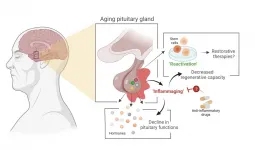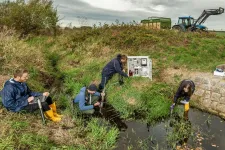Fungal spores from 250-year-old collections given new lease of life
2021-06-15
(Press-News.org) Echoing through history by reviving fungal specimens originally preserved and described a flabbergasting quarter of a millenium ago by the "Father of Modern Taxonomy" Carl Linnaeus, this study highlights the untapped potential of museum collections in modern research programmes. The results have just been published in the renowned Cell Press journal iScience.
The "desert coprinus" fungus Podaxis has fascinated scientists and explorers for centuries, still the genus has been subjected to relatively little research. These large mushrooms thrive in hostile and mostly species-free environments and while they occur seasonally and unpredictably in deserts and on termite mounds, researchers are faced with a problem common to many biologists: Where do we find it? The researchers from the Department of Biology turned to an unconventional sampling location: Museum collections. By requesting fungal spores from various collections, including the Linnaean Society of London and the Natural History Museum of Denmark, they were able to collect more than 200 specimens from every continent aside from Antarctica. The specimens varied in age from 2 to 250 years old.
Specimen from the South African National Collection of Fungi in Pretoria. Photo: Benjamin Schantz-Conlon
Given the finding that fungal spores can grow after 2-5 years in a museum, the limit for their revival was tested. Eventually the researchers succeeded in germinating and growing two Podaxis specimens collected in the 1770s and classified by Linnaeus in Uppsala. These results reveal an extraordinary capacity for Podaxis spores to remain viable through extended periods of drought and suggests that they can remain dormant in the environment for centuries before germinating once conditions allow.
- "It was really incredible to have these fungi growing in our lab, which we knew had been handled by a scientist as important as Linnaeus, who founded the system of naming species. It allowed us to perform experiments and produce genomes of a quality that would have been impossible with dried specimens," explains postdoc and first author Benjamin Schantz-Conlon of the Department of Biology, University of Copenhagen. Benjamin Schantz-Conlon continues: "It was very interesting to examine the adaptations allowing Podaxis to survive under extreme conditions, hereunder also in herbarium collections where the samples traditionally has been treated with mercury as a pesticide".
The researchers used the specimens to ask whether free-living Podaxis species growing in deserts were genomically and physiologically different from species growing on termite mounds. The results indicated that the association with termites gave rise to smaller genome sizes and a reduced tolerance to stressful conditions.
- "These findings suggest that Podaxis living in association with termites are experiencing a relaxed selection pressure and a potential protection from competition and exposure to stressors in the environment", says corresponding author Michael Poulsen, professor at the Department of Biology.
Podaxis growing on a termite mound. Photo: Z. Wilhelm de Beer
Previous research has shown there is an overlap between tolerance to extreme conditions such as deserts and pathogenicity. By comparing the transition from a free-living state in a desert to a symbiotic state within a termite mound, the researchers hoped to learn more about the evolution of fungi that shift to associate with hosts, including pathogens.
- "While Podaxis living in an obligate association with termites exhibited relaxed selection, we also found some Podaxis which could survive both on termite mounds and free-living in deserts. In this case, we saw little genomic or physiological difference between them and the fully free-living Podaxis, suggesting the adaptations for life in the desert may facilitate the initial colonization of termite mounds; something which is also seen in opportunistic pathogens."
An immense resource of knowledge is stored in museum collections and we should work to ensure that these specimens can be used to answer important questions in science in the future.
INFORMATION:
ELSE PRESS RELEASES FROM THIS DATE:
2021-06-15
Hypertension is a widespread comorbidity of patients with obesity that greatly increases the risk of mortality and disability. In recent years, researchers have found that a high-calorie diet increases the density of blood vessels (hypervascularization) in the hypothalamus - an important "eating control" area in our brain. Researchers hypothesized that elevated hormone levels of leptin are associated with a higher risk of developing hypertension. However, the exact mechanisms that contribute to the condensed growth of blood vessels in the hypothalamus were unknown.
New research conducted by Cristina García-Cáceres' research group at Helmholtz Zentrum ...
2021-06-15
Solar activities, such as CME(Coronal Mass Ejection), cause geomagnetic storm that is a temporary disturbance of the Earth's magnetosphere. Geomagnetic storms can affect GPS positioning, radio communication, and power transmission system. Solar explosions also emit radiation, which can affect satellite failures, radiation exposure to aircraft crew, and space activity. Therefore, it is important to understand space weather phenomena and their impact on the Earth.
Space weather research by continuous observation of cosmic rays on the ground is mainly conducted using observation data from neutron monitors and multi-directional muon detectors. Since the phenomenon of space weather is on a short-term, days-long scale, it is effective to investigate changes in the flow ...
2021-06-15
Alkaline zinc-iron flow battery (AZIFB) is well suitable for stationary energy storage applications due to its advantages of high open-cell voltage, low cost, and environmental friendliness. However, it surfers from zinc dendrite/accumulation and relatively low operation current density.
Recently, a research group led by Prof. LI Xianfeng from the Dalian Institute of Chemical Physics (DICP) of the Chinese Academy of Science (CAS) developed layered double hydroxide (LDH) membrane with high hydroxide conductivity and ion selectivity for alkaline-zinc iron flow battery.
The ...
2021-06-15
Light--and all waves--can bend around the corners of obstacles found along its path. Because of this phenomenon, called diffraction, it is impossible to focus light onto a spot that is smaller than half its wavelength. In other words, the highest resolution one can theoretically achieve using an optical microscope is approximately 250 nm, a barrier called the diffraction limit. Unfortunately, this resolution is not enough for observing fine cellular structures, such as those found in neurons.
Over more than a century, microscopists were hamstrung by this classic barrier until the invention of super-resolution fluorescence microscopy. One particularly powerful ...
2021-06-15
Researchers have identified two subgroups of adolescents who self-harm and have shown that it is possible to predict those individuals at greatest risk almost a decade before they begin self-harming.
The team, based at the MRC Cognition and Brain Sciences Unit, University of Cambridge, found that while sleep problems and low self-esteem were common risk factors, there were two distinct profiles of young people who self-harm - one with emotional and behavioural difficulties and a second group without those difficulties, but with different risk factors.
Between one in five and one in seven adolescents in England self-harms, for example by deliberately cutting themselves. While self-harm is a significant risk factor for subsequent suicide attempts, many do not intend suicide but face ...
2021-06-15
A new study by Newcastle University shows that the risk of dolphins and porpoises being caught in small-scale (artisanal) fisheries is highest in low- and middle-income regions around the tropics and sub-tropics.
Marine scientists assessed the risk posed by small-scale fisheries to all 72 species of toothed whales found throughout the world's oceans. They found that this risk was highest in the Central Indo-Pacific, Temperate Northern Pacific, Temperate South America and the Western Indo-Pacific.
Publishing their findings in the journal Fish and Fisheries, the authors ...
2021-06-15
Stem cell biologist Hugo Vankelecom (KU Leuven) and his colleagues have discovered that the pituitary gland in mice ages as the result of an age-related form of chronic inflammation. It may be possible to slow down this process or even partially repair it. The researchers have published their findings in PNAS.
The pituitary gland is a small, globular gland located underneath the brain that plays a major role in the hormonal system, explains Professor Hugo Vankelecom from the Department of Development and Regeneration at KU Leuven. "My research group discovered that the pituitary gland ages as a result of a form of chronic inflammation that affects tissue and even the organism as a whole. This natural process usually goes unnoticed ...
2021-06-15
The inclusion of biological uncertainty and the latest case data can significantly improve the prediction accuracy of standard epidemiological models of virus transmission, new research led by KAUST and the Kuwait College of Science and Technology (KCST) has shown.
Modern mathematical epidemic models have been tested like never before during the COVID-19 pandemic. These models use mathematics to describe the various biological and transmission processes involved in an epidemic. However, when such factors are highly uncertain, such as during the emergence of a new virus like COVID-19, the predictions ...
2021-06-15
Local rice varieties in Vietnam could be used to help breed improved crops with higher resilience to climate change, according to a new study published in Rice.
Earlham Institute researchers are part of an international collaboration with genebanks and rice breeders in Vietnam - championed by the International Rice Research Institute (IRRI) to help abolish world poverty and hunger - are aiming to identify varieties that can survive an increasingly unpredictable climate.
The new genomic data they have generated will significantly support efforts to ...
2021-06-15
Pesticides safeguard agricultural yields by controlling harmful insects, fungi, and weeds. However, they also enter neighbouring streams and damage the aquatic communities, which are crucial for maintaining biodiversity, are part of the food web and support the self-purification of water. In a nationwide monitoring programme, a consortium of scientists led by the Helmholtz Centre for Environmental Research (UFZ) has shown that the governmental thresholds for pesticides are generally too high and that even these excessively high levels are still exceeded in over 80% of water bodies. As they published in the scientific journal Water Research the loss of biodiversity can only be halted if the environmental risk assessment ...
LAST 30 PRESS RELEASES:
[Press-News.org] Fungal spores from 250-year-old collections given new lease of life







